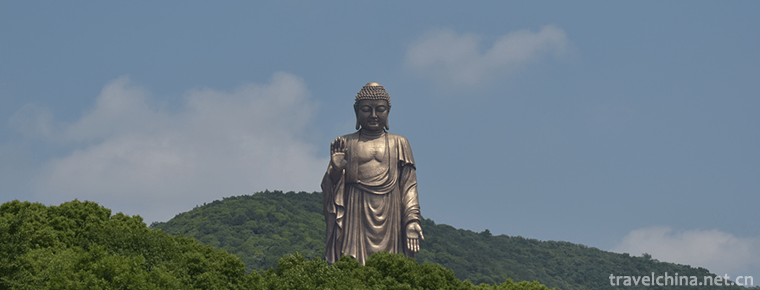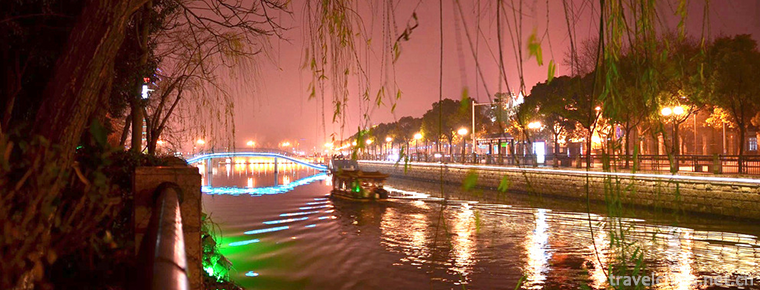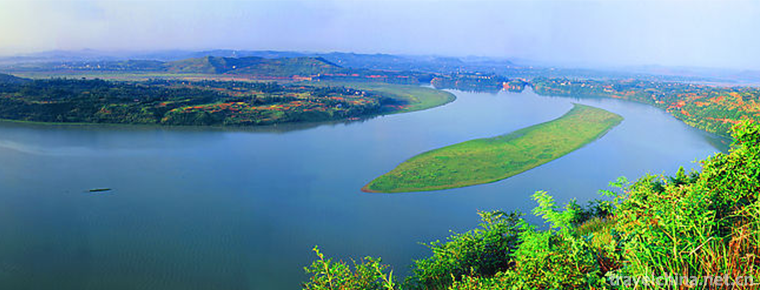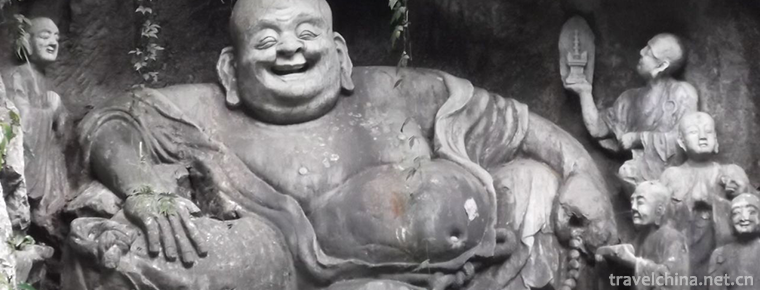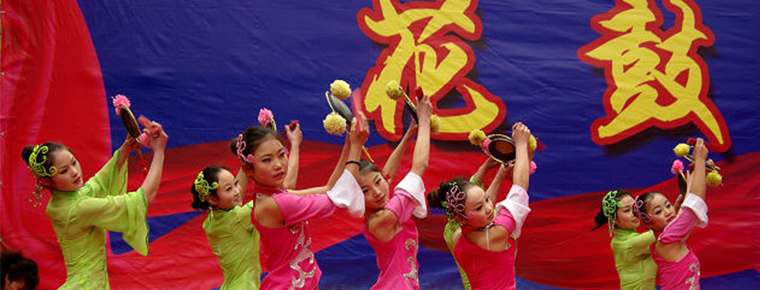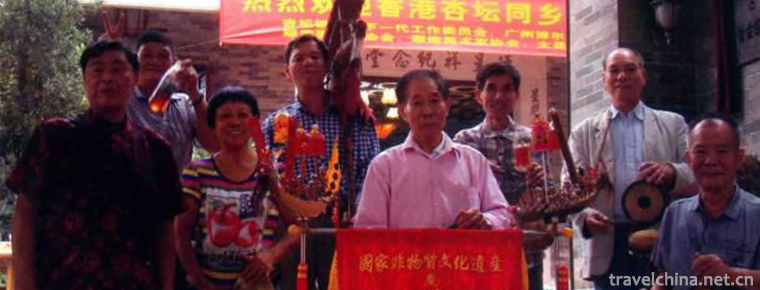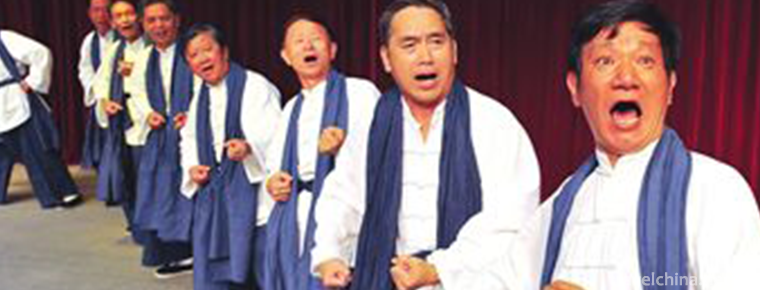Daci Temple
Daci Temple
Daci Temple, also known as the ancient great saint CI temple, is located in the first section of Dongfeng Road, Jinjiang District, Chengdu City, Sichuan Province. It was built between the 3rd and 4th centuries AD, and is known as "the first jungle of the Sinian".
In 622 A.D., Xuanzang reached the age of 20, and was officially ordained in this temple. Emperor Xuanzong of the Tang Dynasty once granted an amount of "imperial edict to build the great saint CI Temple". After its rise and fall, it was destroyed many times by military fire. The existing halls were rebuilt from Shunzhi to Tongzhi in the Qing Dynasty.
History of baocha
Temple building time
Daci Temple in Chengdu, founded in Wei and Jin Dynasties, flourished in the Tang and Song dynasties. It has a long history, profound culture, and large scale. It has been handed down as "the first jungle of Sinian". According to the Buddhist palm of India in Puji's five lamp Huiyuan of the Song Dynasty, it is estimated that the temple was built between the 3rd and 4th centuries A.D. from the 3rd century to the 4th century A.D., which is more than 1600 years ago.
Tang and Song Dynasties
In the first year of Wude of Tang Dynasty (618), master Xuanzang of Sanzang went from Chang'an to Chengdu to study Buddhist scriptures with Buddhist masters such as baosiam, Daoji and Zhizhen. In the spring of the fifth year of Wude (622), Xuanzang was taught in the Law Academy of Daci Temple in Chengdu and studied the law in the summer. During the four or five years of his stay in Chengdu, Xuanzang studied various ministries and often lectured in Daci and Konghui temples, which was admired by Shu people. Xuanzang was not satisfied with this, but sailed to the Three Gorges and took the route from Jingzhou to Chang'an to realize his feat of going to the Western Heaven for Buddhist scriptures. In 756, an Lushan captured Chang'an and Tang Xuanzong took refuge in Chengdu. Xuanzong saw Yinggan, a monk of Daci Temple, giving porridge on the streets of Chengdu to help the poor people and pray for the country. He was deeply moved, but for the British imperial edict "great saint CI Temple" plaque, granted a thousand acres of land. He personally supervised the construction of 8542 Royal monasteries with 96 temples. In the 17th year of Zhengyuan (801), the Puxian Pavilion of Daci Temple was built in Weigao Town, and the Yuxi River flowed through the temple, which made the environment of Daci Temple more perfect and became a well-known Buddhist lecture resort in Tang Dynasty. In the second year of Changqing of emperor Mu Zong of Tang Dynasty (822), the eminent monk Zhixuan (National Master of Wuda) gave a lecture to his Excellency Puxian, and the audience reached more than ten thousand people every day.
In the fifth year of Huichang (845), Wuzong destroyed the Buddha. Daci Temple was the only Buddhist temple preserved in Chengdu at that time, and it was also the largest Buddhist temple in Central Sichuan at that time.
Because Tang Xuanzong and Tang Xizong were lucky to Sichuan, many famous painters also gathered in Chengdu, which made Chengdu painting popular. In Daci Temple alone, there are more than 1000 murals, and there are as many as 60 or 70 national famous painters who left their works. According to the Song Dynasty Li Zhichun's "Secretary of dashengci Temple", there are more Tang paintings than Chengdu, and Chengdu is more prosperous In Song Dynasty, Fan Chengda's notes on ancient temples in Chengdu and Huang Xiufu's record of Yizhou famous paintings also record the author and content of murals in Daci Temple. In the first year of Jiayou of Song Dynasty (1056), Su Shi and his younger brother Su frog traveled to Daci and appreciated the works of lulengjia, a Buddhist painting master of Tang Dynasty. They called the murals of Daci Temple "exquisite and world-famous".
Song people believe that the 455th arhat reincarnation is the founder of Jingzhong and Baotang Zen School. Zen master Daolong of the Song Dynasty became a monk at Daci Temple at the age of 13. After completing his studies in the temple, he led his disciples to Japan in 1246, where he first introduced Zen Buddhism. Later, the emperor cuo'e called for a special visit and ordered the Rensi temple to be built. Daolong lived in Japan for 32 years and had many disciples. His fame can be compared with that of Jianzhen monk in Tang Dynasty. After Daolong's death, he bestowed "master Dajue", which was the beginning of Japanese Zen master's posthumous title.
Daci Temple in the Tang and Song dynasties in its heyday, occupied less than half of the eastern city of Chengdu. It was a famous tourist area in Chengdu at that time. Every temple fair was more lively. The commercial prosperity near Daci Temple has led to the formation of seasonal markets in front of the temple, such as lamp market, flower market, silkworm market, medicine market, Mashi City, Qibao City, etc. At the same time, night markets also formed on both sides of jieyuxi. From Fang xingshenglan's "Yunjin Louguan Jinjiang night market in front of Daci Temple" and Tian Kuang Shi's "climbing Daci Temple pavilion to watch night market" in Fang xingshenglan, this paper illustrates the grand spectacle of night market near Daci Temple in Song Dynasty. The custom of night market has been inherited to modern times.
Ming and Qing Dynasties
In 1435, Daci Temple was destroyed in a fire and rebuilt in the late Ming Dynasty. During the reign of emperor Shunzhi of the Qing Dynasty, Ji Yingxiong, the magistrate, wrote the plaque of "Daci Temple". It was rebuilt again in 1867. On the central axis, there are Shanmen hall, Maitreya hall, Guanyin hall, Daxiong hall, shuotang hall, sutra collection building and Jieyin Hall (demolished by Dongfeng Road in 1958). The buildings on both sides are guest hall, Zhaitang hall, Zen hall and Jietang hall, covering an area of more than 40 mu. Above the Mountain Gate hall, there are stone plaques inscribed on the list of "ancient great saint CI Temple" by Huang Yunhu, the inspector general of Sichuan On the stone pillars of the hall, there are couplets written by Gu Fuchu, a famous scholar of the Qing Dynasty.
modern
In 1981, Daci Temple was announced as a cultural relic protection unit in Chengdu. In 1983, Daci Temple was rebuilt into Chengdu Museum. At the end of 2003, with the approval of Chengdu Municipal People's government, the preparatory group for the restoration and opening of Daci Temple was established. On April 8, 2004, Daci Temple was officially opened to the public. On June 25, 2005, da'en grand monk was awarded the first generation abbot of Zhongxing in Daci Temple, Chengdu.
historical value
The temple was first built in the Song Dynasty, according to the Buddhist palm of India in Puji's "five lanterns Huiyuan" of the Song Dynasty, it was estimated that it was between the 3rd and 4th centuries A.D., more than 1600 years ago. Daci Temple has experienced the rise and fall, and has been destroyed by fire for many times. The existing halls were rebuilt after Shunzhi in Qing Dynasty. There are also some views on the temple, such as the hall of the king, the hall of the emperor and the hall of the emperor. The grand hall and the Sutra building are majestic with gorge stone as columns. The temple is magnificent, the courtyard is deep, and the ancient trees are towering. There are tea garden, Qiyuan, famous snack bar.
Daci Temple in Tang and Song Dynasties was the center of Buddhist academic exchange among China, Korea and Japan. In the Tang Dynasty (now South Korea), Wuxiang Zen master was originally the prince of Silla. In 728, he came to Chang'an in the 16th year of Kaiyuan. He was summoned by Emperor Xuanzong of Tang Dynasty. Later, he went to Sichuan to visit Zen master Zhimi and Chuji. Xuanzong was lucky enough to be summoned to Sichuan and ordered to rebuild Daci temples in Chengdu.
Cultural value
Ancient temple calligraphy
The five characters of "ancient great saint CI Temple" on the mountain gate are dated on the eighth day of the sixth year of Guangxu (1880), which is more than 120 years ago. This shows that the plaque is not a royal plaque written by Xuanzong or Xizong of Tang Dynasty. The ancient plaque, about 70 cm high and 3 m long, was carved from red stone. The model year is "the sixth year of Guangxu Buddha Road day" (that is, the eighth day of the lunar month), and the inscription is "Chu Qi Huang Yun Hu book". There is a small stone plaque on both sides of it, respectively engraved with the words "true liberation gate" and "great bright road".
Famous paintings and bronze statues
In history, the most distinctive and influential cultural relics of Daci Temple are famous paintings and bronze Buddha. According to experts' evaluation, all the portraits of the temple are "unique for a time", which is an extremely precious and rare art treasure house.
According to Huang Xiufu's record of famous paintings in Yizhou and Fan Chengda's notes on ancient temples in Chengdu in Song Dynasty, there are 1215 Buddha statues of various kinds, 262 statues of heavenly king, Ming king and great deity general, and 114 Buddhist scriptures. Su Shi of Song Dynasty was once known as "exquisite crown". Song Li Zhichun's "Da Sheng CI Si Hua Ji" said: "the Tang Dynasty's painting is more prosperous than the great sage CI temple.". In particular, the painting of Luohan crossing the sea by Guan Xiu, a famous monk in Sichuan during the Five Dynasties, is the most famous. There is an inscription on the left side of the original painting by Di Pingzi, the former collector: "on this piece of silk, there is a monk coming to reply. It says: the painting of Guan Xiu, a monk of Shu, crossing the sea at the Tang Dynasty, is hidden in Luohan Pavilion in the sixth ancestral courtyard of Chengdu dashengci temple. Five hundred years later, his disciples came back to visit you and went through it. It is said that there were hundreds of bronze Buddha and stone Buddha in the temple. They were destroyed by war and chaos. Among them, the most famous are two: one was destroyed in 1927; the other was preserved after liberation.
Folk Stories
Hou Jitu, the Minister of Song Dynasty, did not leave a deep impression on his political achievements when he was an official in Chengdu. However, he had a wonderful marriage in Daci Temple, which is well-known in his poems. According to the Song Dynasty's Yuxi Lun Shi, Hou Jitu, even as an official, kept a gentle Confucian demeanor and often visited Daci Temple, a cultural scenic spot in Chengdu. "One day, the autumn wind blows everywhere, and Hou Ji Tu leans against the tower of Daci Temple. There are big Tung leaves floating and falling." There is a poem saying: wipe green convergence double moths, for the depressed heart.
Under the control of the court, the book into Acacia. This word is not calligraphy stone, this word is not book paper.
The book to the autumn leaves, willing to start by autumn wind. People who have a heart in the world should try to solve Acacia death;
People who are ungrateful in the world do not know the meaning of Acacia. If you have a heart or a heart, you don't know where to go.
Moreover, the font on the leaf is also very beautiful. Therefore, Hou Ji Tu took the leaves of tung trees inscribed with poems home and collected them. Five years later, Hou Jitu married Ren, a rich girl in Chengdu. Miss Ren is not only beautiful and intelligent, but also proficient in poetry and prose, but she is often depressed about this involuntary marriage. Once, Miss Ren accidentally found a poem, Tung leaf, extremely surprised. This is the poem she wrote on Tung leaves when she visited Daci Temple five years ago. She took the poem Tongye to Hou Jitu and asked, "this is my wife's book on Ye Shishi's poem. How can it be in public?" Hou Jitu replied, "you can get it by leaning on the fence in the pavilion of Daci Temple." Miss Ren laughed happily. Hou Jitu then said, "that is to say, it is not accidental that we hire you today." Since then, the husband and wife love each other, Hou Jitu is also a successful official.
From the story of Hou Jitu and miss Ren, it is associated with the records in the poem of the original story: Gu Kuang, a poet of the Tang Dynasty, sat on the flowing water at the east gate of Luodong and got the poem on the leaves of Wu
Once in the palace, there is no spring every year. Talk about a leaf, send to have a lover.
Gu Kuang also wrote a poem on the Tung leaves the next day
Flowers fall deep palace warbler also sad, Shangyang palace maid heartbroken.
The imperial city can't help flowing east. Who do you want to send poems on the leaves? Throw it into the stream that flows through the palace. More than ten days later, someone got another poem
A leaf inscribed poem out of the Forbidden City, who is the only one who rewards him.
From the middle of the wave less than the wave, rippling by the current to take the next line.
And show it to Gu Kuang. Seeing it, Gu Kuang could not help but feel dejected and sighed. According to the chronicle of Tang poetry, poet Lu Wo also found a quatrain from Yugou
Why is the running water too fast, the deep palace is idle.
Thank you for your hospitality, so that you can go to the world. There are similar records in qingsuo Gaoyi and Shier Xiaoli. All this makes people feel sad. The poem inscribed by Tung leaves in Chengdu makes people feel happy. The story reflects the ancient literati's idea of Chengdu, which always brings happiness to people.
Charity activities
Daci Temple charity will deliver new year goods to poor families, saving 30 cents a day, and 120 yuan a year. There is an unusual significance in spending this money on public welfare. " Daci Temple in Chengdu is full of love. The Bodhi virtue Association of Daci Temple has raised 20000 yuan to hold an annual New Year charity activity of "giving love and warming the world" to 100 poor families in Jinjiang District. They sent comfort materials to 100 poor families in the three districts of Jinjiang District, such as academies and Hejiangting.
The donation activities mainly benefit the poor families in Jinjiang District, including low-income families, empty nesters and disabled people. "I really appreciate the help of Bodhi Gongde Association, so that we can have a good Spring Festival." The 83 year old Mr. Huang Renhua was old and sick, and his children were not around. When he took the consolation, he was grateful and said "thank you" repeatedly. In addition, for some poor households who could not come to the donation site, the Bodhi Gongde Association of Daci Temple delivered the consolation articles to them from door to door, and took over the donated rice, oil and other daily necessities as well as the Spring Festival consolation money. The poor families were very happy.
According to relevant people of Daci Temple Bodhi virtue Association, the association has more than 2000 members since its establishment two years ago. They save 30 yuan a day and donate 120 yuan to people in need.
Practical information
admission ticket
No tickets required
Opening Hours
8: 00-20:00; vegetarian restaurant: 10:00-14:00, 17:00-19:00
Traffic information
The bus route from major stations to Daci Temple in Chengdu (the fastest):
Starting point: Chengdu East Railway Station - walk to west square station of Chengdu east railway station, take bus No.4, get off at Dongfeng Bridge station and walk to Daci Temple;
Xinnanmen bus station take bus No.301, get off at Dongfeng Bridge station and walk to Daci Temple;
Wuguiqiao bus station of Chengdu Public Transport Group: walk to Wuguiqiao bus station, take bus No.4 (, 58, No.81), get off at Dongfeng Bridge station and walk to Daci Temple;
Beimen Station - walk to liangjiaxiang station, take bus No.28, get off at the second section of Hongxing Road, and walk to Daci Temple;
Chengdu gaosuntang coach station: walk to gaosuntang station, take bus No.18 (or No.166), get off at Shamao North Street station and walk to Daci Temple;
Chadianzi bus station - take bus No.4 and get off at Dacisi station;
Jinsha station: walk to Jinsha bus station, take bus No.81 and get off at Dacisi station;
Chengdu Shiling passenger station: walk to Shiling bus station, take bus No.301, get off at Dongfeng Bridge station and walk to Daci Temple.

-
Grand Buddha at Ling Shan
Lingshan Grand Buddha is a world famous scenic spot, located between the mountains and rivers of Mashan National Scenic Spot in Wuxi City, Jiangsu Province..
Views: 257 Time 2018-12-06 -
Hao River
Haohe River surrounds the old city of Nantong, like a gourd, like a Pearl chain, known as the "emerald necklace" of Nantong City. It is a national 5A tourist attraction..
Views: 189 Time 2018-12-06 -
The First Sangzi in Jialing
The first Sangzi of Jialing is located in Peng'an County, Sichuan Province. Peng'an is the home of Sima Xiangru, a great poet of the Han Dynasty. It is located in the northeast of Sichuan .
Views: 121 Time 2019-01-21 -
Iron Man Wang Jinxi Memorial
The Iron Man Wang Jinxi Memorial Hall was built in 1971 to commemorate the pioneer fighter of the Chinese working class, the Iron Man Wang Jinxi. The Ironman Memorial Hall.
Views: 184 Time 2019-02-22 -
The Legend of the Cloth Bag Monk
From the end of Tang Dynasty to the Five Dynasties, the monk of Fenghua, Ningbo City, Zhejiang Province, named Tingzi, was an eminent monk of Hou Liang in the Five Dynasties.
Views: 381 Time 2019-04-04 -
Hua gu deng Flower drum lantern
Flower drum lantern, a traditional dance in Bengbu City, Fengtai County and Yingshang County, Anhui Province, is one of the national intangible cultural heritage..
Views: 233 Time 2019-05-04 -
Dragon Boat rap
Dragon boat rap, also known as "Dragon Boat", "Dragon Boat Song", "Dragon Island Song" or "Shunde Dragon Boat", is a popular form of folk art in the Pearl River.
Views: 117 Time 2019-05-14 -
Wharf song
The dock number is a traditional folk song in Shanghai. Singing in docks, cargo yards, loading and unloading, lifting, push and pull and other labor occasions. The main singing methods of wharf number.
Views: 96 Time 2019-05-16 -
Panzhihua scenic spot
Gesala Ecotourism Area is a national AAAA tourist attraction, a provincial tourist resort and a provincial ecotourism area. It is located in the northwest of Panzhihua City, about 110 km away from the urban area. There are ten thousand acres of pines, azalea sea, Yi People's customs and Tiankeng floor drain..
Views: 114 Time 2020-12-14 -
Neijiang secondary industry
By the end of 2019, there were 329 Industrial Enterprises above Designated Size in Neijiang City, and the added value of industries above designated size increased by 9.5%. The added value of the five traditional pillar industries increased by 9.8%, including.
Views: 332 Time 2020-12-16 -
Meishan administrative division
Meishan City has 6 county-level administrative divisions (Municipal District 2, county 4), and 80 township level administrative divisions (street 13, town 62, township 5). It covers an area of 7134 square kilometers and has a population of 3.5 million. Meishan Municipal People's Government in Dongpo District Meizhou Avenue West Section 2..
Views: 325 Time 2020-12-18

